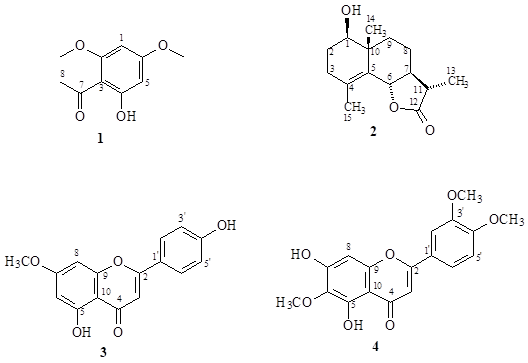COMPONENTS OF ARTEMISIA SOGDIANA
UDC 547-314+547.972+548.75+539.143.43
Abstract
Phytochemical research and effective use of medicinal flora in the future create the basis for the development of the domestic pharmaceutical industry and allow not only to fill the deficit of drugs, but also contribute to the development of new, environmentally friendly and a number of qualities of unique, export-oriented preparations.
The plants of the genus Artemisia L. are rich sources of biologically active secondary metabolites. Phytochemical study of secondary metabolites of plants of the genus Artemisia has led to the creation on their basis, in particular, on the sesquiterpene lactones, antitumor (Artemisinin and its derivatives; Arglabin), antiatherosclerotic (Leucomisin (preparation Oligvon)), cardiotonic (Tauremisin), anthelmintic (α-Santonin) and antimalarial (Artemisinin and its derivatives) preparations.
In order to search for natural biologically active compounds, we studied the components of the alcohol extract of the aerial part of Artemisia sogdiana Bunge, collected during budding in the Zaamin district of the Jizzakh region of Uzbekistan. The result of phytochemical research for the first time from this plant is isolated a phenolic compound xanthoxylin, sesquiterpene lactone artesin, flavonoids genkwanin and eupatilin, the structure of which is established on the basis of spectral data.
Downloads
Metrics
References
Kapustina L.A., Torrell M., Valles J. Shrubland ecosystem genetics and biodiversity: proceedings. Department of Agri-culture, Forest Service, Rocky Mountain Research Station, 2000, pp. 104–112.
Vvedenskiy A.I., Kamelin R.V. Opredelitel' Sredney Azii. Kriticheskiy konspekt flory. [Key to Central Asia. Critical Flo-ra Abstract]. Tashkent, 1993, vol. 10, p. 581 (in Russ.).
Özek G., Özek T., Göger F., Asilbekova D.T., Sagdullaev Sh.Sh., Başer K.H.C. SCNC-2015: Abstracts of 11th Inter-national Symposium on the Chemistry of Natural Compounds. Antaliya, 2015, p. 91.
Mukhamatkhanova R.F., Bobakulov Kh.M., Sham'yanov I.D., Abdullayev N.D. Khimiya rastitel'nogo syr'ya, 2017, no. 2, pp. 133–136, DOI: 10.14258/ jcprm.2017021591 (in Russ.).
Sun W., Sneng J. Brief Handbook of Nat. Active Compounds. Med. Science and technology Press of China, Beijing, 1998.
Goss I.J.M. A Textbook of Materia Medica, Pharmacology, and Special Therapeutics, with Many New Remedies, of Late Introduction. Chicago, 1889, pp. 57–58.
Lall N. Medicinal Plants for Holistic Health and Well-Being. Academic Press, 2017, p. 161.
Akyyev B., Kasymov Sh.Z., Sidyakin G.P. Khimiya prirodnykh soyedineniy, 1972, no. 6, pp. 733–735, DOI: 10.1007/BF00564590 (in Russ.).
Kawazoe K., Morishita N., Nagao A., Takaishi Y., Honda G., Ito M., Takeda Y., Kodzhimatov O. К., Ashurmetov O. Natural Medicines, 2003, vol. 57, no. 3, pp. 114–116.
Çalişkan Z., Gören N., Watson W.H. Journal of Chemical Crystallography, 2004, vol. 34, no. 5, pp. 307–309, DOI: 10.1023/B:JOCC.0000026275.39368.fc.
Sokolov P.D. Rastitel'nyye resursy SSSR. Tsvetkovyye rasteniya, ikh khimicheskiy sostav, ispol'zovaniye. [Plant re-sources of the USSR. Flowering plants, their chemical composition, use]. St. Petersburg, 1993, vol. 7, p. 60 (in Russ.).
Isaev I.M., Agzamova M.A., Isaev M.I. Chemistry of Natural Compounds, 2011, vol. 47, no. 1, pp. 132–134, DOI: 10.1007/s10600-011-9857-9.
Li Y., Hong J., Li H., Qi X., Guo Y., Han M., Wang X. Drug Delivery, 2017, vol. 24, no. 1, pp. 1491–1500, DOI: 10.1080/10717544.2017.1384519.
Nasr Bouzaiene N., Chaabane F., Sassi A., Chekir-Ghedira L., Ghedira K. Life Science, 2016, vol. 144, pp. 80–85, DOI: 10.1016/j.lfs.2015.11.030.
Martini N.D., Katerere D.R., Eloff J.N. Journal Ethnopharmacology, 2004, vol. 93, no. 2–3, pp. 207–212, DOI: 10.1016/j.jep.2004.02.030.
Gao Y., Liu F., Fang L., Cai R., Zong Ch., Qi Y. PLOS ONE, 2014, vol. 9, no. 5, article e96741, DOI: 10.1371/journal.pone.0096741.
Kumarasamya Ya., Coxa Ph.J., Jasparsb M., Naharb L., Sarkerc S.D. Natural Product Communications, 2006, vol. 1, no. 8, pp. 641–644.
Mukhamatkhanova R.F., Bobakulov Kh.М., Sham’yanov I.D., Аbdullaev N.D. Chemistry of Natural Compounds, 2017, vol. 53, no. 4, pp. 750–751, DOI: 10.1007/s10600-017-2109-x.
Tkach S.M., Onishchuk L.A. Novosti meditsiny i farmatsii, 2017, no. 15(634), URL: http://www.mif-ua.com/archive/article/45383 (in Russ.).
Oh T.Y., Ahn G.J., Choi S.M., Ahn B.O., Kim W.B. World Journal of Gastroenterology, 2005, vol. 11, no. 47, pp. 7450–7456, DOI: 10.3748/wjg.v11.i47.7450.

Copyright (c) 2020 Khimiya Rastitel'nogo Syr'ya (Chemistry of plant raw material)

This work is licensed under a Creative Commons Attribution 4.0 International License.

This work is licensed under a Creative Commons Attribution 4.0 International License.
The authors, which are published in this journal, agree to the following conditions:
1. Authors retain the copyright to the work and transfer to the journal the right of the first publication along with the work, at the same time licensing it under the terms of the Creative Commons Attribution License, which allows others to distribute this work with the obligatory indication of the authorship of this work and a link to the original publication in this journal .
2. The authors retain the right to enter into separate, additional contractual agreements for the non-exclusive distribution of the version of the work published by this journal (for example, to place it in the university depository or to publish it in a book), with reference to the original publication in this journal.
3. Authors are allowed to post their work on the Internet (for example, in a university repository or on their personal website) before and during the review process of this journal, as this may lead to a productive discussion, as well as more links to this published work.











